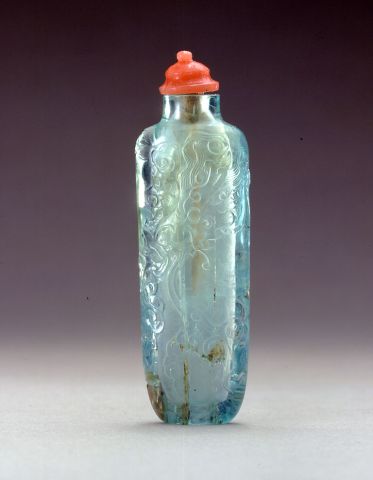
Bottle ID: 340
AQUAMARINE, CARVED
Date: 1750-1800
Height: 62 mm
Aquamarine, of slender upright form with a concave foot, well hollowed and carved in low relief with a vigorous dragon exhaling auspicious vapor and emerging from clouds, the reverse with a phoenix about to perch on a massive rock surrounded by flowering peonies.
Possibly Imperial, attributed to the Palace Workshops.
Similar Examples:
Crane Collection no. 397
Kleiner, Robert. Chinese Snuff Bottles - The White Wings Collection, 1997, p. 194, no. 134.
Stevens, Bob C. The Collector's Book of Snuff Bottles, 1976, pp. 170-171, no. 641.
Moss, Hugh, Victor Graham and Ka Bo Tsang. A Treasury of Chinese Snuff Bottles - The Mary and George Bloch Collection, 1998, Vol. 3, pp. 117-118, no. 411.
Sotheby's, New York, September 14, 2010, lot 162, The Joe Grimberg Collection.
Provenance:
Clare Lawrence Ltd.
Sotheby's, New York, October 25, 1997, lot 106
Gerry P. Mack
It is always assumed that bottles made of semi precious stone are 19th century and even late into the century, however aquamarine was used in the late 18th century predominantly as beads for Imperial court necklaces. The Qianlong Emperor’s prime minister Heshen was known to have a collection of around 1400 snuff bottles, of which approximately 300 are recorded to have been of semi precious stones. It is likely, therefore, that some of these were manufactured from aquamarine as well as other stones such as amethyst and tourmaline. Certainly the carving on this bottle would lend itself to an 18th century date and a possible Imperial attribution.
A warning to collectors who display their bottles, that aquamarine is one of the material that is affected by exposure to both sunlight and heat, resulting in the color fading to white.
< Back to full list

 English
English 中文
中文